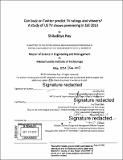| dc.contributor.advisor | Scott Stern. | en_US |
| dc.contributor.author | Ray, Shiladitya | en_US |
| dc.contributor.other | System Design and Management Program. | en_US |
| dc.coverage.spatial | n-us--- | en_US |
| dc.date.accessioned | 2017-09-15T15:27:37Z | |
| dc.date.available | 2017-09-15T15:27:37Z | |
| dc.date.copyright | 2014 | en_US |
| dc.date.issued | 2014 | en_US |
| dc.identifier.uri | http://hdl.handle.net/1721.1/111289 | |
| dc.description | Thesis: S.M. in Engineering and Management, Massachusetts Institute of Technology, Engineering Systems Division, 2014. | en_US |
| dc.description | Cataloged from PDF version of thesis. | en_US |
| dc.description | Includes bibliographical references (pages 46-50). | en_US |
| dc.description.abstract | Watching television has always been a social activity. People like to sit down with friends and family to watch it and then discuss it not only with one's friends and family but at work (water cooler conversations). Just as television has moved ahead with advances in technology, so too has our viewing habits changed with technology. The advent of the internet brought in online forums where people could interact with other fans and discuss opinions on TV shows (amongst others). The new wave of social media applications brought in yet another platform for viewers to express their opinions. Twitter, founded in 2006, and one of the poster childs of social media wave, provided a real-time platform for users to express their opinions and follow what other people are discussing or any other trending topic. Television networks have embraced social TV on the assumption that social media makes people less likely to use time-shifting technologies and hence skip advertising. Twitter provides the perfect platform for television audiences to interact with each other in real-time. Through several strategic initiatives, Twitter has established an early lead as a big player in the Social TV space. Television networks also wooed its audience through various actions on Twitter and other social technology platforms. This paper looks at the impact of actions of networks and viewers on Twitter on the ratings and viewership figures for shows which premiered in Fall 2013 on US television networks. One of the key findings was that current episode's ratings and viewership were significantly correlated with previous episode's. Further, ratings were correlated to the number of tweets by the show handle in the week leading upto an episode airing whereas viewership is more correlated with community actions and engagement. | en_US |
| dc.description.statementofresponsibility | by Shiladitya Ray. | en_US |
| dc.format.extent | 93 pages | en_US |
| dc.language.iso | eng | en_US |
| dc.publisher | Massachusetts Institute of Technology | en_US |
| dc.rights | MIT theses are protected by copyright. They may be viewed, downloaded, or printed from this source but further reproduction or distribution in any format is prohibited without written permission. | en_US |
| dc.rights.uri | http://dspace.mit.edu/handle/1721.1/7582 | en_US |
| dc.subject | Engineering Systems Division. | en_US |
| dc.subject | System Design and Management Program. | en_US |
| dc.title | Can buzz on Twitter predict TV ratings and viewers? : a study of US TV shows premiering in fall 2013 | en_US |
| dc.type | Thesis | en_US |
| dc.description.degree | S.M. in Engineering and Management | en_US |
| dc.contributor.department | System Design and Management Program. | en_US |
| dc.contributor.department | Massachusetts Institute of Technology. Engineering Systems Division | |
| dc.identifier.oclc | 1002855123 | en_US |
